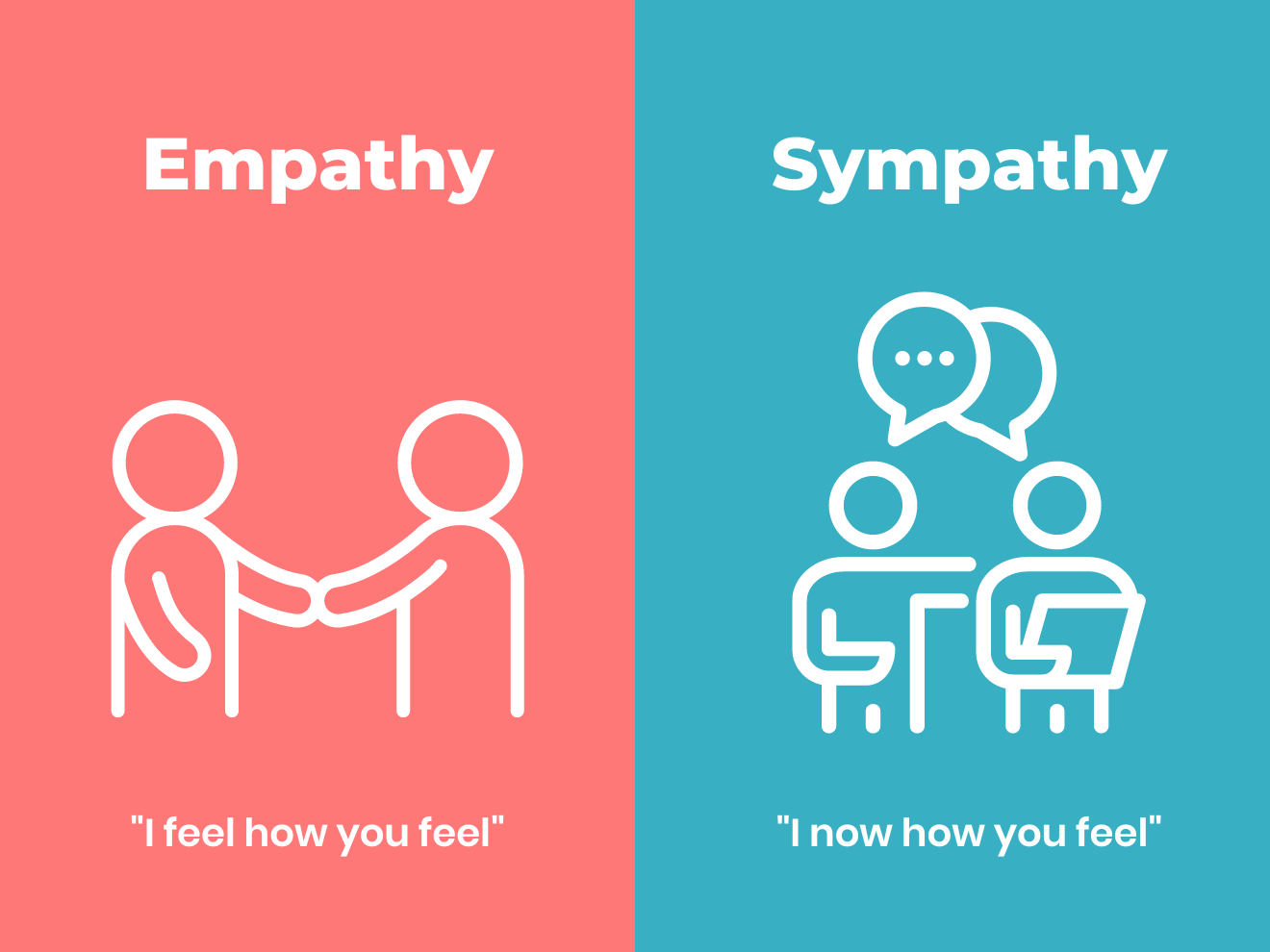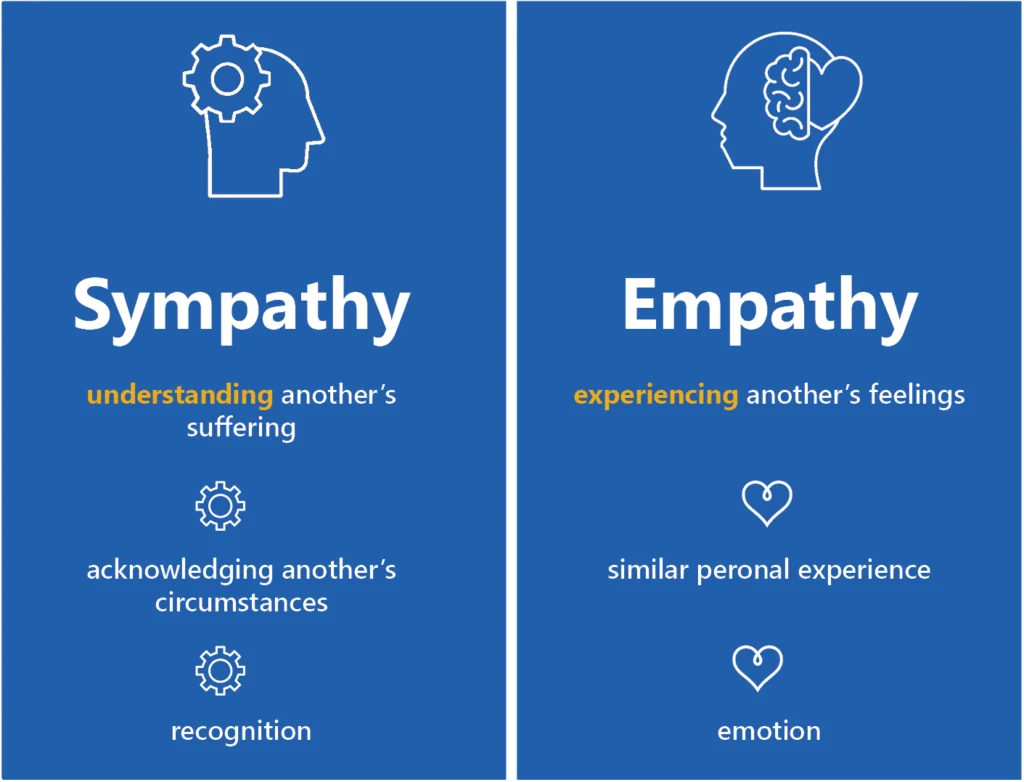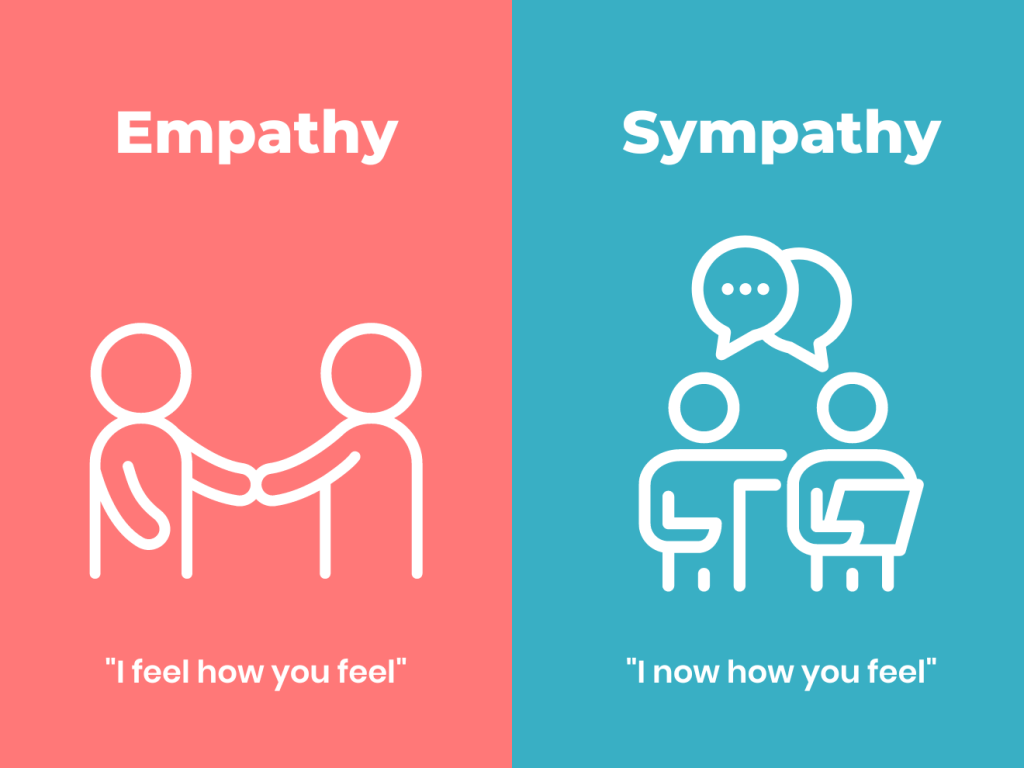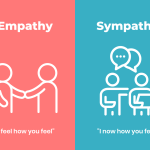Now Reading: Feeling With or Feeling For? Empathy or Sympathy?
-
01
Feeling With or Feeling For? Empathy or Sympathy?
Feeling With or Feeling For? Empathy or Sympathy?

In our everyday lives, we often mix up sympathy for empathy and vice versa. While we may
use them interchangeably, they do represent two distinct emotional responses. Different, yet similar enough, as they represent two sides of the same coin.
How many times have you jumbled these oh-so similar phrases while speaking or writing?
Me?
Too many times to count.
We might as well shed light on the differences between sympathy and empathy.
Alright, dust off your old dictionaries, ‘cause you’re gonna need ‘em. According to common knowledge, both concepts share the suffix: -pathy, which comes from the Greek word pathos, meaning “feelings” or “emotions”. The differences between empathy and sympathy are to be found in the first syllable of each word.
The sym- in sympathy is a variation of the prefix syn-, which means “together” in Greek. In other words, when you use the word sympathy, you are talking about two separate entities that are closely aligned—they are together.
The em- in empathy is a variation of the Greek prefix en-, meaning “in”. If one is “in” another, there is just one—not two together.
Empathy represents feeling with another. Sympathy represents feeling for another. And if the above haven’t convinced you of the key differences between the two yet, let’s further investigate the subject down below.
–>What Is Sympathy?
Sympathy can be defined as “a feeling of sincere concern for someone experiencing something difficult or painful.” The acknowledgment of the needs and suffering of others while maintaining a certain level of detachment. You feel bad for them … but you don’t know what it is like to be in their shoes.
Nowadays, it’s largely used to convey commiseration, pity, or feelings of sorrow for someone else who is experiencing misfortune. While sympathy can be valuable when accompanied by warmth and genuine support, it can sometimes create an emotional barrier between you and the person in distress. It might come up as mean, apathetic or outright cruel in the person in the other end of the line, even if all your “helpful” critique and advice are well-intentioned.
It’s like driving by someone on the side of the highway with a flat tyre and saying, “Poor thing”. But ultimately, sympathy does not motivate us to connect with others. We can sympathize while zooming by that stranded driver, leaving them to deal with the flat tire alone.
–>What is Empathy?
Empathy is defined as “the action of understanding, being aware of, being sensitive to, and vicariously experiencing the feelings and thoughts of another.” Empathy is the active ability to understand and resonate with another person’s feelings while establishing an emotional bond. It enables individuals to feel truly understood and conveys a sincere nonjudgmental effort to “put yourself in someone else’s shoes”.
Empathy is choosing to “Rejoice with those who rejoice, weep with those who weep” (Romans 12:15 ESV). However, beneath rejoicing and weeping, it is digging in to truly listen to and know someone so you can ultimately internalize their experience.
[Note that empathy is very close to compassion, although this last notion takes it a step further to designate the willingness to help and alleviate the distress of the person in pain.]
In simple words:
Empathy is shown in how much compassion and understanding we can give to another. Sympathy is feeling sorry for another. Empathy is our ability to understand how someone feels and imagine ourselves in their place, while sympathy is our relief in not having the same problems. Two terms that can be applied to various emotional outbursts of happiness, anger, fear, sorrow and so on and so forth…
–>Strengths and Weaknesses
…Now, to get some misconceptions out of the way: Empathy and Sympathy are both good traits to have because they offer support for people who need it. These feelings are what make us human and it is what compels us to reach out and offer help. On one hand, while ,yes, empathy is considered by the general public as “better”, it is exhausting. Empathy entails deep commitment and emotional connection, traits that if practiced non-stop for every single person on every single occasion, will eventually burn us out. In the modern world, where chaos and horror consume our lives, not everyone can afford to be an empath 24/7. (Not at least without a break once in a while). On the other hand, a sympathetic stance is a more “professional” and typical reaction to engage with someone, but never the less useful.
Sympathy allows us to learn about oppression, pain and tragedy without being blinded by our emotions. It’s opens an objective and unprejudiced passage to the exploration of foreign, abstract or new subjects in our lives and our environment.
…Still though, when it comes to the people we are given to love and care for—our family, friends, neighbors, coworkers, general community—empathy is essential. In fact, the depth of your relationships will be determined by the depth of your empathy. A good example of this occurrence playing a big part in, for example, the medical field is a study done by the American National Library of Medicine about advanced cancer patients’ understandings, experiences, and preferences of “sympathy,” “empathy,” (and “compassion”):
“Sympathy was described as an unwanted, pity-based response to a distressing situation, characterized by a lack of understanding and self-preservation of the observer. Empathy was experienced as an effective response that acknowledges and attempts to understand individual’s suffering through emotional resonance.”
–>6 Step guide on how to be more empathetic
After exasperatingly over-analyzing Empathy and Sympathy, is there anything more to say? Well, I’m glad you asked because yes there is! For everyone still interested and not yet tired of my yapping, you should know that the first step in being an Empath is acknowledging the definition of your subject. The next step is actually putting it to practice!
Let’s check out 6 easy tools that will allow you to evolve not only as an listener, but as a person:
- Show up and Be Present not just on a typical manner, but on a deeper level. Stand by their darkest moments, feel their pain and most importantly,… words do not always matter. In these moments, simply your presence and your compassion is often the solution in and of itself.
- Be a good listener, because connection isn’t just verbal communication. Entering into conversations, paying attention to their words and being invested about the most mundane stuff in their life could mean the world to your friend. Practice mirroring. The act of reflecting someone to themselves is a amazing method to make someone feel seen and validated. Try to connect with people by using phrases like “Tell me how that feels” or “Tell me more about that”.
- Resist the urge to jump to problem-solving mode. Most of us think way too highly of ourselves and are way too quick to offer our opinions. People rarely need our rants about what they should have done or what you would have done. Most people—most of the time—just need to be heard. When we tell people how they should fix their problems, they’ll only feel more incompetent or out of control.
- Don’t compare their suffering. We often try to make sense of our pain by comparing our situation with someone who is better or worse off than we are. This is called comparative grief, and it is pointless and damaging. Do not remind them that things could be worse. Simply acknowledge the pain of what this person in front of you is going through, no matter how big or small.
- Read Fiction! That is right, what better way to experience such complex emotions than a good book. Many authors often delve deep into the concept of communication, empathy and how other cultures process the world. An easy way to test the waters and get a better grasp on other peoples’ believes.
–>In Conclusion
“Empathy” and “Sympathy” are very common yet so abstract concepts. Similar yet very different. In our attempt to understand them better, we often forget the emotions they embody. They represent the humanity in people. The natural observation and understanding of ones’ suffering or euphoria on different levels. They entail the emotional maturity someone has gained over time and their willingness to listen and feel alongside somebody else.
This article was conducted not as scientific research in a topic well overstretched already. Nevertheless, as a practice to pinpoint our flaws in emotional reactions to someone’s pain. That includes me too, as an “author”, as a student, as a friend and a daughter. That includes you too, the reader, whether you might fell indifferent about this topic or you are genuinely invested in my work.
As a final sendoff, I have a simple request to make. To you and to myself. Next time we encounter a person in need, from our close circle of friend and family, to simple acquaintances in our scroll or on the job, ask them if they are all right. With genuine concern and interest, a bit of empathy or sympathy would do wonders. Anything of the two would be great honestly.
Because we all are well aware, that in this day and age not everyone will try to empathize and not everybody will care to sympathize. So, might as well give it a shot, right?
Sympathy is hard, and Empathizing is harder…
…But ignorance takes double the effort and triple the skill to implement.
- Venus
Even More Sources Below!
-“Empathy” vs. “Sympathy”: What’s the Difference?
-What is Sympathy? Understanding the Structure of Other-Oriented Emotions
-The Difference Between Empathy vs Sympathy
-Mental Health in the AEC – Sympathy vs Empathy
-Empathy vs. Sympathy: What’s the Difference?

























